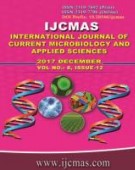


 National Academy of Agricultural Sciences (NAAS)
National Academy of Agricultural Sciences (NAAS)

|
PRINT ISSN : 2319-7692
Online ISSN : 2319-7706 Issues : 12 per year Publisher : Excellent Publishers Email : editorijcmas@gmail.com / submit@ijcmas.com Editor-in-chief: Dr.M.Prakash Index Copernicus ICV 2018: 95.39 NAAS RATING 2020: 5.38 |
Aerial parts and roots of Nauclea latifolia are reported to be effective in the treatment of malaria by ethnomedical practitioners. This effect has been variously reported by laboratory experiments for the leaves but none yet for the roots. The aim of this study was to investigate the efficacy of ethanolic extract and fractions of Nauclea latifolia roots on Plasmodium berghei infected mice. Forty (40) Plasmodium berghei infected mice were divided into 8 groups of 5 mice each and were orally treated with drugs (artesunate at 5 mg/kg body weight of mice), (amodiaquine at 30 mg/kg body weight of mice) and ethanol extract and fractions of Nauclea latifolia (150 mg/kg body weight of mice) once daily for a period of 5 days. The results showed that whole ethanolic extract, and extract fractions of ethyl acetate, butanol and aqueous solvents, gave significantly (p<0.05) good results with respect to HB count and key haematological indices, which compared well with results obtained for standard drugs (Arthesunate and amodiaquine). These fractions and the standard drugs tested reversed anemic conditions usually observed in malaria patients when compared to the negative control group that showed high levels of anemia, leucocytosis and thrombocytopenia based on the assessment of their haematological parameters. Overall the dichloromethane fraction did not show favourable haematological and pharmacological effects on Plasmodium berghei infected mice. It was concluded in this study that Nauclea latifolia roots may be a future candidate for novel antimalarial drug development in Nigeria.
 |
 |
 |
 |
 |